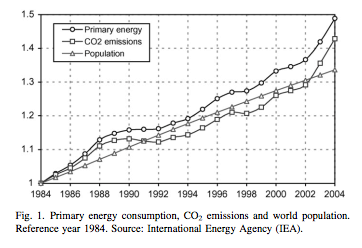Energy efficiency and energy savings are at the topmost goal of every commercial building owner and facility manager. This is because buildings account for 41% of the total energy consumption in the United States.
Moreover, building-sector energy consumption grew by 48% between 1980 and 2009.

This is due to population growth, increased use of appliances and enhancement of building services and comfort levels.
This proliferation in energy consumption has led to an increase in carbon dioxide emissions that has made energy saving strategies a primary objective in most countries.
Building Management systems (BMS) or Building Automation and Control Systems (BACS) or Building Control System (BCS) have come a long way from the 1960s. In the 60s and 70s, these systems were manually controlled. The data was written in a log book and the building facility managers made energy adjustments based on their experience and intuition.
The ‘80s and ‘90s saw the adoption of some digital controls. They still had to integrate the various controls of mechanical, electrical, and plumbing (MEP) systems. This led to the Building management systems, where there was an increase in automation of building operations. Unfortunately, these were not integrated systems without any established standards of communication between these systems.
The 2000s brought in a change in building landscapes, enhanced automation and control techniques and standardization in energy operations.
The old management systems of the ‘90s need modernization because most of them utilize obsolete practices for energy efficiency. There is a need for modern, state-of-art systems with enhanced capabilities.
An essential question is how can you recognize the need to modernize and adopt technologically advanced solutions for your energy saving needs?
In this article, we will take a look at 3 different modern methodologies that would help you identify what areas of your building management systems need improving and can benefit from retrofitting your premises for sustainable measures
1.) The IoT and energy management systems
Low cost, easy to install, energy harvesting sensors and controls
The Internet of Things(IoT) is a term used for internet-based systems that connect and extend the physical environment using devices and sensors. The global number of devices being managed by utility companies is projected to grow from 485 million in 2013 to 1.53 billion in 2020.

Some examples of these devices are meters, grid sensors, actuators etc. that can be used for monitoring and control, metering, asset management, tracking and communication.
The benefits that IoT solutions provide for energy management far outweigh the costs of installation of such systems. They provide a real-time view of energy usage, identify ways to reduce cost using continuous monitoring and manage systems when energy tariff is low. For example, a facility manager can control and monitor energy consumption on every floor of the building. It can also help with detection of energy loss/theft/fraud as well as improve response time when outages occur.
Embedded IoT sensor devices can help facility engineers to understand the entire network of utilities in real-time. Data collected from these devices include temperatures, pressures, humidity, flow rates, vibrations and calibrations. Facility operators can use this data for preventive maintenance on not only above-ground systems but also those below ground like cables, wires and pipes.
The following are some of the priorities when considering implementing an IoT system:
• Security: Security is a top concern for any IoT implementation. You must plan to secure IoT systems, sensors, devices, network as well as data. A combination of traditional network firewalls and security applications along with embedded security into end point devices will help prevent security breaches. Designing security into IoT applications from ground up is very important.
• End-User experience: Understanding how IoT solution can help your top priorities for energy efficiency is important to build a system that would quickly provide a good ROI (Return on Investment). For example, your building might suffer for frequent outages, hence designing the application for continuous monitoring and control should be the priority for the initial roll-out of the IoT implementation.
• Pilot programs: There is no such thing as a perfect implementation of a system. Agile methods can be used to quickly pilot and launch systems. These can be iterated upon quickly based on feedback provide. This will also help you to innovate continuously as the technology capabilities are mature year after year.
2. Green Building Initiatives:
According to USGBC, a green building is a “holistic concept that starts with the understanding that the built environment can have profound effects, both positive and negative, on the natural environment, as well as the people who inhabit buildings every day.”
Green buildings help with the sustainable goals of United Nations, that set forth a challenge for everyone to deal with economic growth, climate change, poverty and inequality.
A green building helps attain several of these 17 sustainable goals. The infographic below provided by the World Green Building Council shows some of the benefits of becoming a green building.
 Increase building efficiency with green buildings
Increase building efficiency with green buildings
The following are some of the ways to make a building green:
• Efficient use of energy, water and other resources
• Use of renewable energy, such as solar energy
• Pollution and waste reduction measures, and the enabling of re-use and recycling
• Good indoor air quality
• Use of materials that are non-toxic, ethical and sustainable
• Consideration of the environment in design, construction and operation
• Maximizing utilization of daylight to reduce overhead lights
• Incorporating energy-efficient lighting and motion sensors
Retrofitting existing buildings to become green buildings is the most cost-effective way to support the sustainable environment movement.
You can follow some of these recommendations depending on your budget, priorities and risk:
- Perform an energy audit to replace old and inefficient systems, leaks, clogged filters, stuck dampers, disabled sensors, faulty or incorrect wiring and lack of knowledge to maintain equipment.
- Review utility bills over a two-year period to determine the rise or fall of energy consumption. Make adjustments if there is a rise and need for increased savings – both dollars and energy
- Evaluate occupancy patterns and apply sensors in appropriate locations. Incorporate energy efficient lights where applicable.
- Employ Energy Star and/or a green building rating system for existing buildings like LEED for Existing Buildings: Operations and Maintenance (LEED EBOM) or Green Globes for Existing Buildings to gage the building's level of performance.
3.) Smart Buildings:
Building energy management systems (BEMS) have a contradicting goal of reducing energy consumption while maintaining the comfort of the occupants. As buildings age, their thermal characteristics deteriorate, indoor spaces get rearranged, and usage patterns change.
These factors create a climate inside the building that might not be maintained according to the outside climate. Hence the energy performances of most buildings fall short of expectations.
This complexity along with large quantities of constantly changing data makes traditional energy efficiency systems inadequate. Modern technology solutions provide a robust and optimal answer to the conundrum of energy efficiency and occupant comfort in buildings. These systems are called Smart Building systems use integrated technology that connects a variety of subsystems, which typically operate independently, so that these systems can share information to optimize total building energy performance.
Smart Buildings are also very responsive to facility managers, facility engineers and occupants.
Some of the features that Smart Building systems provide are:
- User access control: This is a dashboard that enables visibility into all the connected systems including but not limited to HVAC, lighting, water usage, security and others. This provides a birds eye view or in depth details as required by the facility manager.
- Real-time monitoring/control: A facility engineer can monitor and control in real-time multiple buildings data on a graphical user interface. They can use the information to make informed decisions. For example, using this information they can turn off lights and reduce cooling when occupants leave the building.
- Alarm notifications: Based on your configuration, alarms, warnings and notifications can be sent to your mobile as a voicecall or SMS so that you can receive any urgent information promptly.
- Proactive equipment maintenance: Analysis algorithms detect problems in performance before they cause expensive outages, maintaining optimum efficiency along the way. By responding to alternate usage in electricity, a smart building ensures the lowest possible energy costs and often generates revenue by selling load reductions back to the grid.
Below is an image of a smart building:
 Increase building efficiency with smart buildings
Increase building efficiency with smart buildingsSmart Building solutions extend well beyond energy efficiency and sustainable environment. They can extend the usage of the equipment as well as ensure safety and security of both human and other resources.
Conclusion:
As your building management systems age, they require more maintenance, run less efficiently and experience more downtime and become unreliable. Add to that the new age technologies that support environmental friendly initiatives like Green and Smart Buildings. These modern tools, techniques and initiatives provide you with a way to discover opportunities of improvement in your existing systems.
Adoption of any of the 3 aforementioned methods would lead to an effective energy management system that increases your property’s value, extends the life of energy assets, generates savings, minimizes the risk of equipment failure and reduces your building’s environmental impact.





